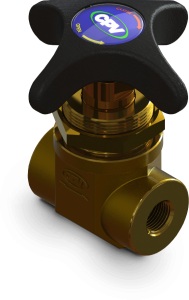Oxygen Valve Quality Hinges on Compatibility and Cleanliness
Any compressed gas poses a potential risk of ignition and corresponding hazards. Oxygen for example, does not burn by itself. However, it supports combustion and, if not properly contained and managed, oxygen can react explosively or cause spontaneous ignition of other materials. This risk increases as oxygen is put under pressure and as temperatures rise.
CPV Manufacturing fabricates oxygen control valves for oxygen filling systems. Several industries and applications rely on pressurized oxygen stored in cylinders or containers, such as medical, pharmaceutical, chemical, welding, and waste treatment, among others. Quality, durability, and sensitivity all factor into selection of an oxygen valve that supplies the proper balance of control and protection.

Oxygen Highly Regulated Due to Hazard Potential
OSHA standards regulate bulk oxygen systems installed on industrial and institutional consumer locations. The U.S. Department of Transportation (DOT) considers medical oxygen a hazardous material, regulating its transportation, and the U.S. Food and Drug Administration (FDA) classifies it as a prescription drug.
State fire codes regulate its handling. International agencies are no exception, with a publication available from the European Industrial Gases Association (EIGA) that discusses the valves involved in their control and specifications for a proper oxygen valve.
Oxygen Valve Purpose and Placement
An oxygen valve controls and regulates the flow of pressurized oxygen gas, stored in cylinders or traveling through pipelines. Of all the components within the system, the part most prone to issues and subsequent system failure is the valve.
Issues related to an improperly functioning oxygen valve can include rapid pressure change and subsequent heat generation or leaks. Many of these issues and their associated dangers are discussed in a previous blog post found here.
Quality and Durability Begin with Compatible Material Selection
CPV manufactures all oxygen valves of either naval brass or Monel®, depending on customer preference. Naval brass is a copper alloy that contains zinc for extra strength in fact, making naval brass stronger than other types.
The zinc content in naval brass (39%) also makes it less ductile than brass containing less zinc. A hint of lead helps make it machinable and the addition of one percent tin increases its corrosion resistance.
Monel(®) is a nickel/copper alloy and typically more expensive than naval brass. Either choice is highly compatible with oxygen applications.
Customers should avoid oxygen valves made of materials susceptible to oxidation or corrosion, which will weaken the valve and could create a leak. An iron containing material for example, can add moisture to the oxygen, stimulating a chemical reaction that will lead to corrosion.
Copper alloys have proven to be the most effective among metal options to resist ignition because a copper alloy has the slowest combustion rate. For any type of hazardous gas containment or control, naval brass is a preferred selection for fire and explosion safety purposes.
Oxygen Cleaning and Government Certifications
Our cleaning process, CPV OX-1, meets the cleaning standards for oxygen cleaning and packaging per the Compressed Gas Association (G-4.1) and ASTM-G93, or related cleanliness standards.
Separate standards exist for government issue valves. CPV Mfg. and its aqueous component cleaning process recently received approval by NAVSEA for MIL-STD-1330D and MIL-STD-1622B Oxygen Cleaning.
Obtaining this approval enables CPV to meet the needs of the U.S. Navy and other applications that would benefit from military grade or intensive cleaning standards.
The MIL-STD-1330D applies to other systems outside of oxygen, including Department of Defense Standard Practice, Precision Cleaning and Testing of Shipboard Oxygen, Helium, Helium-Oxygen, Nitrogen, and Hydrogen Systems.
Reliability and Design Functionality
CPV earns the business of new customers who come to the company because their other valves are leaking and are unreliable. CPV valve customers will find our oxygen valve is the most robust and well-designed oxygen valve available. While no valve is ever completely worry free, operators can anticipate a service life that lasts for thousands of cycles without leaking or other issues.
In many cases, CPV valves are rated for higher pressures than most competitors. In the United States, an oxygen valve pressure expectations are typically a maximum of 4,500 PSI (307 BAR). CPV oxygen valves exceed that to meet overseas standards for 6,000 PSI (414 BAR).
Our valves also feature a soft seated design, which includes a Vespel® SP-21 Disc for bubble-tight, leak-free performance, at the highest-pressure ratings for oxygen valves.
Clean Room Packaging and Training
CPV expanded its cleanroom in 2021 and is certified to meet ISO 14644 Class 7 standards. Our employees are trained and certified as Oxygen Clean Workers and validated to meet MIL-STD 1330D standards.
All oxygen valves manufactured at CPV are thoroughly wiped down and packaged in the clean room in a double-layered vacuum-sealed bag, protecting them from moisture or contamination up to the point of installation.
Find more information, including specifications and available sizes for the CPV OXNB ® O-EAL® Series of valves includes a Naval Brass Oxygen Valve, for oxygen service in fill plants, high-pressure manifolds, and other piping systems, visit pages 32 and 33 of our catalog.
The CPV GSB Master valves also service high-pressure gas shutoff and control, with approval for 6,000 PSIG operating pressure in oxygen service for commercial applications worldwide, for safe, reliable control. Learn more about GSB Master Valves or visit our main company site at www.cpvmfg.com.

